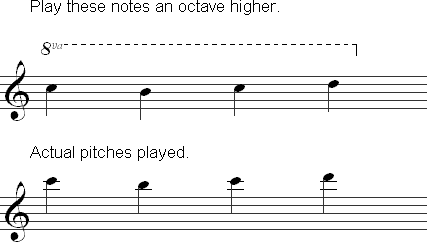The Staff
Notes on the Staff
Music is written on a five line/four space staff:

Treble Clef
Guitar music is notated in the treble clef.

Notes on the Lines
Notes are placed on lines and spaces. The position of a note on the staff indicates the pitch of the note. The notes on the lines are E, G, B, D, F (bottom to top).

A mnemonic device for remembering the order of these notes is 'Every Good Boy Does Fine'. The first letter of each word corresponds to the letter on each line of the staff.
Notes on the Spaces
Notes on spaces are spelled F, A, C, E (bottom to top). Use the word 'FACE' to make it easy to remember the order of notes on the spaces.

Notes Played at the Same Time and in Succession
When notes are stacked on top of each other, they should be played at the same time. Individual notes should be played in succession, one after another.

Ledger Lines
Ledger lines extend the staff beyond five lines. They are used for notes that don't fit on the five line/four space staff and can extend the staff up or down.

Transposing Instrument
The guitar is a transposing instrument. This means that the written pitch is different from the sounding pitch. Guitar music sounds one octave lower than writen.

Other Symbols on the Staff
Time Signatures
Time signatures appear at the beginning of the music or any time the time signature changes.

Key Signatures
Key signatures appear at the beginning of each line of the music.

Measures and Barlines
Barlines are vertical lines that divide the music into measures. Measures have a specific number of beats based on the time signature.

Some musicians use the word "bar" instead of measure. The two words are interchangeable and most musicians will know what you mean regardless of which word you use.
Double Barlines
Double barlines are two veritical lines that are side by side. The barlines can either be the same thickness or the second line can be thicker than the first. A double bar line where the lines are the same thickness indicates the end of a section.

End Barlines
A double bar line where the second line is thicker indicates the end of a piece.

Pickup Measures
Pickup measures are measures that have fewer beats than specified in the time signature. For example, a piece in 4/4 time might start with a pickup measure that is one beat long.

Many pieces make up the time from the pickup measure by including a shortened measure at the end of the piece. For example, a piece in 4/4 that begins with a one-beat pickup measure might end with a measure of three beats so that the pickup and ending measure together equal one four-beat measure.

Raising and Lowering a Note by an Octave
There are several indications for specifying that notes should be played one or two octaves higher or lower than the written note.8va and 15ma
8va above a note or series of notes means to play those notes an octave higher. If the symbol is used over several notes a dotted line will be used in addition to the 8va symbol. 15ma works in the same way as 8va, but the note sounds two octaves higher. These symbols are used to avoid excessive ledger lines in passages that would otherwise require them.

8vb and 15mb
8vb and 15mb work the same way as 8va and 15ma, but lower the pitch by an octave (8vb) or two octaves (15mb). These are generally only used if the music is in bass clef, so you won't see either of these indications on guitar very frequently.
loco
The word loco may be used over a note after an 8va, 15ma, 8vb, or 15mb passage to indicate that the note is to be played as written.
